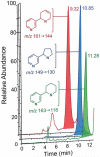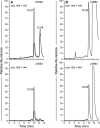Quantitation of the Minor Tobacco Alkaloids Nornicotine, Anatabine, and Anabasine in Smokers' Urine by High Throughput Liquid Chromatography-Mass Spectrometry
- PMID: 26825008
- PMCID: PMC5155587
- DOI: 10.1021/acs.chemrestox.5b00521
Quantitation of the Minor Tobacco Alkaloids Nornicotine, Anatabine, and Anabasine in Smokers' Urine by High Throughput Liquid Chromatography-Mass Spectrometry
Abstract
Nicotine is the most abundant alkaloid in tobacco accounting for 95% of the alkaloid content. There are also several minor tobacco alkaloids; among these are nornicotine, anatabine, and anabasine. We developed and applied a 96 well plate-based capillary LC-tandem mass spectrometry method for the analysis of nornicotine, anatabine, and anabasine in urine. The method was validated with regard to accuracy and precision. Anabasine was quantifiable to low levels with a limit of quantitation (LOQ) of 0.2 ng/mL even when nicotine, which is isobaric, is present at concentrations >2500-fold higher than anabasine. This attribute of the method is important since anatabine and anabasine in urine have been proposed as biomarkers of tobacco use for individuals using nicotine replacement therapies. In the present study, we analyzed the three minor tobacco alkaloids in urine from 827 smokers with a wide range of tobacco exposures. Nornicotine (LOQ 0.6 ng/mL) was detected in all samples, and anatabine (LOQ, 0.15 ng/mL) and anabasine were detected in 97.7% of the samples. The median urinary concentrations of nornicotine, anatabine, and anabasine were 98.9, 4.02, and 5.53 ng/mL. Total nicotine equivalents (TNE) were well correlated with anatabine (r(2) = 0.714) and anabasine (r(2) = 0.760). TNE was most highly correlated with nornicotine, which is also a metabolite of nicotine. Urine samples from a subset of subjects (n = 110) were analyzed for the presence of glucuronide conjugates by quantifying any increase in anatabine and anabasine concentrations after β-glucuronidase treatment. The median ratio of the glucuronidated to free anatabine was 0.74 (range, 0.1 to 10.9), and the median ratio of glucuronidated to free anabasine was 0.3 (range, 0.1 to 2.9). To our knowledge, this is the largest population of smokers for whom the urinary concentrations of these three tobacco alkaloids has been reported.
Figures




References
-
- United States Department of Health and Human Services . The Health Consequences of Smoking: 50 Years of Progress. A Report of the Surgeon General. U.S. Department of Health and Human Services, Centers for Disease Control and Prevention, National Center for Chronic Disease Prevention and Health Promotion, Office on Smoking and Health; Atlanta, GA.: 2014. Smoking attributable morbidity, mortality and economic cost; pp. 647–680.
-
- U.S.Department of Health and Human Services . The Health Consequences of Smoking: 50 Years of Progress. A Report of the Surgeon General. U.S. Department of Health and Human Services, Centers for Disease Control and Prevention, National Center for Chronic Disease Prevention and Health Promotion, Office on Smoking and Health; Atlanta, GA.: 2014. Patterns of Tobacco Use Among U.S. Youth, Young Adults and Adults. pp. 701–770.
-
- Donny EC, Denlinger RL, Tidey JW, Koopmeiners JS, Benowitz NL, Vandrey RG, al'Absi M, Carmella SG, Cinciripini PM, Dermody SS, Drobes DJ, Hecht SS, Jensen J, Lane T, Le CT, McClernon FJ, Montoya ID, Murphy SE, Robinson JD, Stitzer ML, Strasser AA, Tindle H, Hatsukami DK. Randomized trial of reduced-nicotine standards for cigarettes. N. Engl. J. Med. 2015;373:1340–1349. - PMC - PubMed
Publication types
MeSH terms
Substances
Grants and funding
LinkOut - more resources
Full Text Sources
Other Literature Sources
Medical

